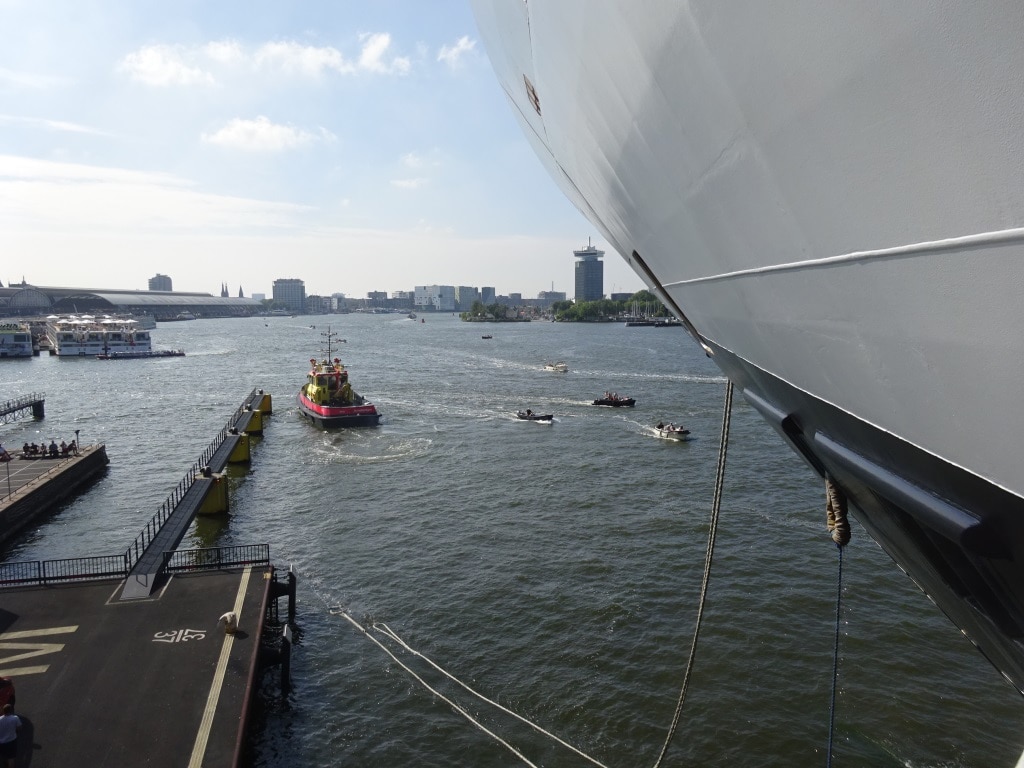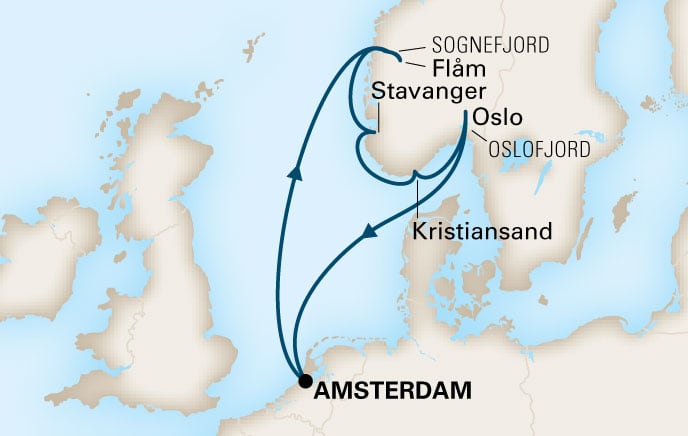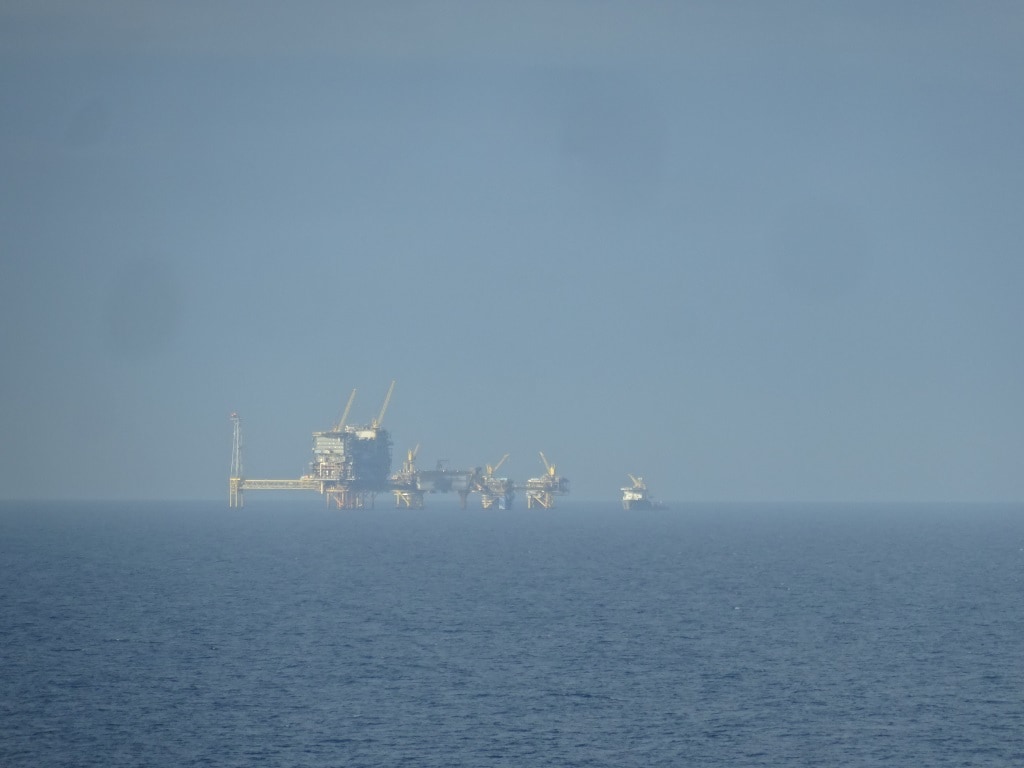We departed right on time as the captain needed all the time available to make it to the first port, Flam (Also spelled as Flaam unless you can do a zero or O on top of the a) on time. When we left the dock we had an escort boat from the Harbor Master ahead of us to keep the Sunday sailors and the six pack navigators out of the way. Lots of them milling around in the main channel of the IJ (Or Y in English), sometimes with floating contraptions which should not be in such open and busy waters at all. Everybody in Holland who wants to operate a boat over 15 meters or anything that goes faster than 20 kilometers an hour needs a license. But it sometimes looks like as if all skippers, varying from bathtubs, to small sailing boats, motor yachts and even the Rhine barges seem to develop a general amnesia about what was learned when sailing around a large ship. For floating things of 14.99 meters and less, it is in general even worse. The Koningsdam has a dead angle of 60 meters from the line Bow to Bridge and once inside that line, the bridge has no clue of what is going on there below and just has to hope that things go ok and the officer forward can keep an oversight. While for the average small boater 10 feet of passing distance is more than adequate, ………………… it’s not for us. Thus a traffic control boat to help us out is well appreciated.

The escort boat in position. See how close the little boats come while the ship starts to maneuver? Only the white one is visible from the bridge. These will be out of the way before the ropes are in, so the escort boat is leaving them in peace.
We are now embarking on a seven day “Viking Saga” cruise with calls at Flaam, Stavanger, Kristiansund, Oslo and then back to Amsterdam. In all the ports we stay until 5 or 6 pm. to ensure that the guests get as much scenic cruising as possible. Sunset is every evening after 11 pm. hence opportunity galore to see Norway at its best.
 Just after 21.00 last night we were well into the open waters again and turned north towards Norway and the Sognefjord. And today we had a quiet day at sea. The officers on the bridge really appreciate these days as on cruises like this the port days are so hectic that a peaceful sea day is a nice way to recuperate and relax. The high light of this morning’s 4 -8 watch was: one course change of 3o to port to stay on the track line. That is one click on the button to confirm that the automatic pilot can do its job. The equipment is now so sophisticated that we could sail into port, and almost to the dock, only on the instruments as long as there would be no traffic in the way. Similar but at the same time different to the airline industry. Airplanes normally fly in set lanes or corridors and do not meet traffic. If they do then you normally read about in the newspapers. Airlines can and do fly completely on instruments and can do this also for take off and landing. Ships sometimes follow Vessel Traffic Separation Schemes where traffic follows the same route. But for most of the seas and ocean, it is a free for all (Mare Librium as the old folks used to say) so traffic can come from all sides.
Just after 21.00 last night we were well into the open waters again and turned north towards Norway and the Sognefjord. And today we had a quiet day at sea. The officers on the bridge really appreciate these days as on cruises like this the port days are so hectic that a peaceful sea day is a nice way to recuperate and relax. The high light of this morning’s 4 -8 watch was: one course change of 3o to port to stay on the track line. That is one click on the button to confirm that the automatic pilot can do its job. The equipment is now so sophisticated that we could sail into port, and almost to the dock, only on the instruments as long as there would be no traffic in the way. Similar but at the same time different to the airline industry. Airplanes normally fly in set lanes or corridors and do not meet traffic. If they do then you normally read about in the newspapers. Airlines can and do fly completely on instruments and can do this also for take off and landing. Ships sometimes follow Vessel Traffic Separation Schemes where traffic follows the same route. But for most of the seas and ocean, it is a free for all (Mare Librium as the old folks used to say) so traffic can come from all sides.
Watch keeping on the ships has changed as well. We used to, and many shipping company’s still do, operate the 4 hours on and 8 hours off watch schedule. (Not off work but not standing on the bridge) That schedule worked quite well in my opinion as long as the captain allowed a rotation through the watches. I used to do as much as possible giving each officer in a 3 month period, a month in each watch. 4-8 was the gentleman’s watch; with time to do side duties the mornings, have a nap in the afternoon and dine with the guests in the evening or see a show. 8-12 was the party watch. Finishing at noon and the Officers Bar was just opening, finishing at midnight and in the ship or in the Officer Bar the party was just getting into full swing. Then finally there was the 12 – 4 watch. This was the lonely watch. In the afternoon the ships staff took a nap to prepare for the evening activities, so you hardly saw anybody and the same after midnight, it was very quiet as well. That is nice for some contemplation but it is not good to be in this watch month after month as it can get very lonely. In the past I knew a few people who had spent 10 years in this watch before they were promoted up into the 4 -8. One did notice a number of peculiarities that they had developed in those years and not all of them were positive. Which watch you went into depended on your seniority and if promotion was at a standstill, you could be stuck for years.

Even when it is quiet you have to be careful as the North Sea is full of these oil rigs. And the people on board there get very nervous when you come close. For ships coming too close they have a Guard Ship on duty as you can see to the left of the rig.
Since the arrival of the full time double watch system, two officers on the bridge at all times, the company has been experimenting with 6 and 2 and 5 and 3 hour watch systems. Basically to see if more rest hours could be taken in one block and to give some more time off. With the old watch system, taking out the side duties and eating and sleeping, you had to swap watch hours to get some decent time ashore. Now the hours are more together. In the end the company decided on 5 and 3 hours. As an example, the dog shift does 22.00 to 03.00 in the morning and then 09.00 to 12.00 hrs. The officers are off from 11.00 hrs in one go to 22.00 hrs. again. Or they do 00.00 hrs. to 05.00 hrs. and then 09.00 to 12.00 hrs. Again a nice long stretch of time off. The officers on the ships like the system and they also rotate through the watches during their contract. Nobody gets bored and everybody can get a share of the good life.
Late this evening we will be at the pilot station and then we enter the Sognefjord which is the longest and deepest fjord in Norway. All the way at the end is the town of Flam, known worldwide for its railway. We will be docking tomorrow morning and I will be forward again with the senior cadet to get the ropes ashore. Not just to get the ropes ashore but in accordance with Holland America Line standards and there is a big difference there.
Weather for Flam: Overcast with a chance of showers in the afternoon and 73oF or 23oC. It looks like that we have the real Norwegian summer weather back.

July 23, 2018 at 9:23 pm
Captain,
Always an interesting read! Your discussion on watchstanding made me realize how things are changing. Those are some interesting schedules you discuss – and an opportunity for a longer rest period, too.
I know on some American merchant ships (where there are only three watch standers), the tradition is the Chief Mate would take the 4-8 (better to supervise the day work on deck), the 8-12 would go to the Third Mate (civilized hours sleep-wise, but mostly because it allows for better oversight by the awake Captain), and the 12-4 for the Second Mate – as the “navigator” he/she could handle the noon position and report.
Kevin
July 27, 2018 at 9:27 pm
Hi Captain Albert
Reading your blog with great interest as usual. Your dissertation on the HAL watch system left me dumbfounded. I know that you know all the pro/cons but that was hard to glean from your description.
Not to worry. If you know the system I’m good !!!!
Ruud Hartog